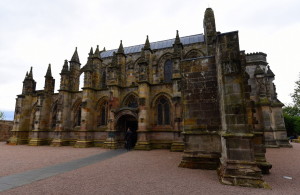For many people, popular culture is an enticing “in” to their travels. When visiting a new city, a strong homing instinct pulls us to the landmarks we’ve seen on TV or in the movies. (On my first visit to New York City, I just had to check out the coffee shop from Seinfeld.) Working on our guidebooks, I could just dismiss the locations attached to famous movies or TV shows. But let’s face it: In Scotland, people are as every bit as interested in seeing the Hogwarts Express viaduct or the Outlander castle as they are in the more “serious” sights.
Of course, pop culture ebbs and flows. Right now, Outlander is on the upswing. Harry Potter has plateaued. And The Da Vinci Code books and DVDs are gathering dust in bargain bins. A decade ago, in the hubbub surrounding Dan Brown’s page-turner, we added a few Da Vinci Code landmarks to our guidebooks. Updating our Edinburgh material on this trip, I came across a listing for the Rosslyn Chapel (where the climax of the novel and the film are set). And, given the declining interest in the Da Vinci Code, I almost took it out of the book without another thought.
But thank goodness I made the trip out to see it. Sitting in the countryside about a half-hour outside of Edinburgh, the Rosslyn Chapel is a riot of carved iconography. It was built in the mid-15th century as the personal burial chapel for the aristocratic St. Clair family. Master stonemasons were brought in to slather the building, inside and out, with a stunning mishmash of Christian, pagan, family, Templar, and other symbolism. While romantics and historians have always been fascinated with Rosslyn, the docent told me that annual visits more than quadrupled after the publication of The Da Vinci Code (funding, among other things, extensive restoration works and a slick new visitors center).
Exploring the carvings, you’ll see everything from the seven deadly sins and the seven acts of mercy to a puffy-cheeked angel playing bagpipes, serenading a skeleton dancing with its human form. The family’s symbol (an “engrailed,” or serrated, cross) is everywhere, as are more than a hund red “green men” — chubby faces with leaves and vines growing out of their orifices. This paradise/Garden of Eden theme is enhanced by a smattering of exotic animals (monkey, elephant, camel, dragon, and a lion fighting a unicorn) and some exotic foliage: aloe vera, trillium, and corn.
red “green men” — chubby faces with leaves and vines growing out of their orifices. This paradise/Garden of Eden theme is enhanced by a smattering of exotic animals (monkey, elephant, camel, dragon, and a lion fighting a unicorn) and some exotic foliage: aloe vera, trillium, and corn.
Of all the chapel’s fanciful carvings, it’s that last one — the lowly corn — that really captured my imagination. (I wasn’t allowed to take a photo of the corn, but you can find plenty of pictures if you do a Google Images search for “Rosslyn corn.”) These carvings date from the mid-to-late 15th century, certainly well before Columbus sailed the ocean blue, at a time when corn was unknown in Europe. So how did it wind up here? Some claim that the father of the chapel’s builder explored the New World before Columbus. That seems like a stretch. Other theories are more feasible: The St. Clairs were of Norman (Viking) descent, with strong ties to the Orkney Islands (which were part of Norway throughout the Middle Ages). Perhaps some depiction of corn from the Viking explorations of the New World (around A.D. 1000) remained a part of family lore, until it was immortalized in this chapel. The most practical solution: Maybe it’s not corn at all — maybe it’s just stylized stalks of wheat.
Is the Holy Grail, some great Templar treasure, or anything else hidden in a secret underground vault at Rosslyn, as Dan Brown and others have speculated? I don’t know — and don’t care. I just want the skinny on that corn.
Pondering mysteries like this, it’s clear why Rosslyn Chapel still grabs the attention of historians, novelists, and tourists. It also reinforces my feeling that there’s no point being a snob about pop culture, because in many cases, it succeeds in pointing travelers to worthwhile (and otherwise underrated) sights. Just keep in mind that a film or TV appearance is just one more little blip in the centuries-long history of a fascinating place. If you use pop culture as an excuse to travel, that’s wonderful…but let it be a starting point, rather than an end in itself.
This May we visited Rosslyn Chapel on a beautiful sunny day. It was one of our favorite places. We especially enjoyed the hike to the castle ruins.
My wife, younger daughter, and I visited this chapel 15 years ago, long before it was portrayed in Dan Brown’s book. We were there on a typically grey, Scottish day, and we pretty much had the place to ourselves. The interior of the building was stunning, of course, but the outside was surrounded by scaffolding — not exactly a photographer’s dream. But, the operators had no barriers up to keep us from climbing the scaffolding to inspect the exterior carvings along the roof line in detail. Nobody yelled at us to come down, so we spent the better part of an hour leisurely checking out the architectural features. We got pictures from a perspective that will never be open to the public again. The site was struggling then, trying to figure out how to protect the exterior of the building from further erosion. The exhibits were poor. Dan Brown’s book opened the floodgates for this place. The money these new visitors spent there may have helped preserve the Chapel. A focus by pop culture isn’t always a bad thing.